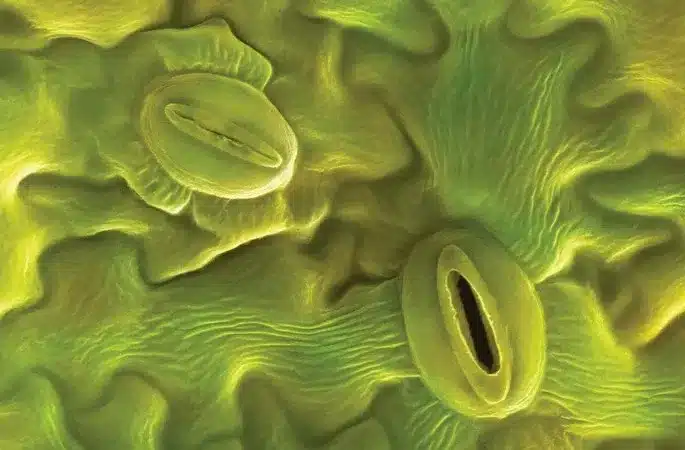About Stomata
- Stomata are tiny openings or pores in plant tissue that allow for gas exchange.
- They are typically found in plant leaves but can also be found in some stems.
- Stomata allow a plant to take in carbon dioxide, which is needed for photosynthesis.
- They also help to reduce water loss by closing when conditions are hot or dry.
- Stomata look like tiny mouths which open and close as they assist in transpiration.
- Plants that reside on land typically have thousands of stomata on the surfaces of their leaves.
- The majority of stomata are located on the underside of plant leaves, reducing their exposure to heat and air current.
- In aquatic plants, stomata are located on the upper surface of the leaves.
- A stoma (singular for stomata) is surrounded by two types of specialized plant cells that differ from other plant epidermal cells. These cells are called guard cells and subsidiary cells.
- Guard cells are large, crescent-shaped cells, two of which surround a stoma and are connected to at both ends.
- A stomate opens and closes in response to the internal pressure of guard cells.
- These cells enlarge and contract to open and close stomatal pores.
- Guard cells work to control excessive water loss, closing on hot, dry, or windy days and opening when conditions are more favourable for gas exchange.
- Guard cells also contain chloroplasts, the light-capturing organelles in plants.
- Subsidiary cells, also called accessory cells, surround and support guard cells.
- They act as a buffer between guard cells and epidermal cells, protecting epidermal cells against guard cell expansion.
- For most plants, dawn triggers a sudden increase in stomatal opening, reaching a maximum near noon, which is followed by a decline because of water loss.
Q1) What is Photosynthesis?
Photosynthesis is the process used by plants, algae and some bacteria to turn sunlight into energy. The process chemically converts carbon dioxide (CO2) and water into food (sugars) and oxygen. The chemical reaction often relies on a pigment called chlorophyll, which gives plants their green color.
Source: Discovery of amino acid unveils how light makes stomata open in plants
Last updated on December, 2025
→ Check out the latest UPSC Syllabus 2026 here.
→ Join Vajiram & Ravi’s Interview Guidance Programme for expert help to crack your final UPSC stage.
→ UPSC Mains Result 2025 is now out.
→ UPSC Notification 2026 is scheduled to be released on January 14, 2026.
→ UPSC Calendar 2026 is released on 15th May, 2025.
→ The UPSC Vacancy 2025 were released 1129, out of which 979 were for UPSC CSE and remaining 150 are for UPSC IFoS.
→ UPSC Prelims 2026 will be conducted on 24th May, 2026 & UPSC Mains 2026 will be conducted on 21st August 2026.
→ The UPSC Selection Process is of 3 stages-Prelims, Mains and Interview.
→ UPSC Result 2024 is released with latest UPSC Marksheet 2024. Check Now!
→ UPSC Prelims Result 2025 is out now for the CSE held on 25 May 2025.
→ UPSC Toppers List 2024 is released now. Shakti Dubey is UPSC AIR 1 2024 Topper.
→ UPSC Prelims Question Paper 2025 and Unofficial Prelims Answer Key 2025 are available now.
→ UPSC Mains Question Paper 2025 is out for Essay, GS 1, 2, 3 & GS 4.
→ UPSC Mains Indian Language Question Paper 2025 is now out.
→ UPSC Mains Optional Question Paper 2025 is now out.
→ Also check Best IAS Coaching in Delhi

















